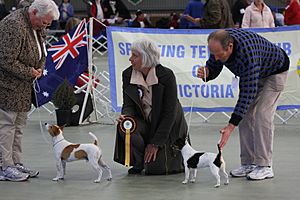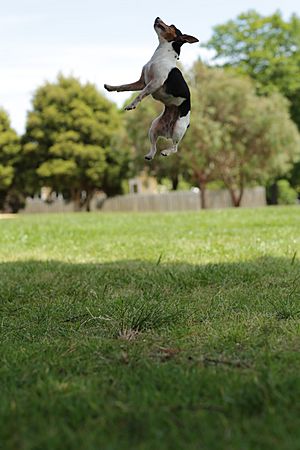Tenterfield Terrier facts for kids

Two champion Tenterfield Terriers: a tan and white; and a tri-colour.
|
|
| Origin | Australia |
|---|---|
| Domestic dog (Canis lupus familiaris) | |
The Tenterfield Terrier is a small, energetic dog breed from Australia. These dogs are strong, active, and quick. Their short, smooth coat makes them easy to care for, perfect for families. They are known for being hardy and agile.
Contents
What Tenterfield Terriers Look Like
Tenterfield Terriers are mostly white, as required by their breed rules. They have a balanced look, with no features that stand out too much. Their body is square or compact. Their head is wedge-shaped, meaning it gets narrower towards the nose.
These dogs can have ears that stand up (pricked ears) or ears that are partly upright (semi-erect). Pricked ears are more common. Tenterfield Terriers usually stand about 28 cm (11 inches) tall. They come in different colors:
- Tan and white
- Black and white
- Tri-colored (black, tan, and white)
- Tri-colored (liver, tan, and white)
A special thing about them is their naturally short tail, called a bob tail. It can be any length.
How the Breed Started
The ancestors of the Tenterfield Terrier came to Australia with the first European settlers. These dogs sailed from England. They were chosen because they were excellent at catching vermin, like rats, on ships. Small dogs were much better for this job in the tight spaces of a ship. These small terriers were like miniature versions of the Fox Terrier.
By the late 1800s, a type of dog called the Miniature Fox Terrier was common in rural Australia. People called them "Mini Foxies." They were great at hunting pests and were also good family pets. By the 1920s, these dogs were popular in cities too.
The name "Tenterfield" doesn't mean the dog came from that exact town. It might have come from a famous breeder. These small terriers were bred in many places around northern New South Wales. The town of Tenterfield is famous in Australian history for a speech about Australia becoming independent. A man named George Woolnough, who owned a saddlery in Tenterfield, was known to love these terriers.
The name Tenterfield Terrier was suggested in the 1990s by a TV gardening personality named Don Burke.
Developing the Breed
In 1991, a group of dog lovers in South Australia started a club for the Miniature Fox Terrier. This club was separate from an older club. In 1992, they met with owners from other states to talk about the future of the breed. They realized that people had different ideas about what the Miniature Fox Terrier should look like. Also, there were questions about the name "Miniature Fox Terrier." This made it hard for the breed to be officially recognized by the ANKC.
So, in January 1993, the Tenterfield Terrier Club of Australia Inc was formed. Most of the dog owners from New South Wales, Western Australia, and South Australia voted for this. In 2002, the Tenterfield Terrier was officially recognized by the ANKC. It was placed in Group 2, which is the Terrier group.
The Tenterfield Terrier now has its own breed standard, which is different from the Miniature Fox Terrier. Even though they can sometimes be confused, these two breeds have been developing separately for a while and are now considered different breeds.
Health and Personality
Even though they are small, Tenterfield Terriers are friendly and outgoing. They are brave, like most terriers, and very smart. Their coat is easy to take care of and doesn't need much grooming.
Tenterfield Terriers can live a long time. While some can live up to 20 years, most live between 12 and 14 years in good health.


